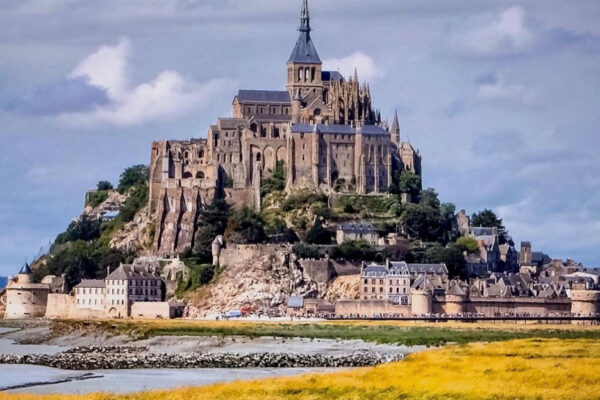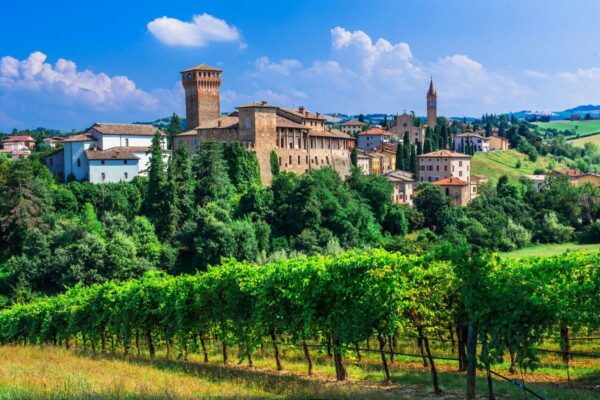Portugal: 4½ Fabulous (mostly) Days
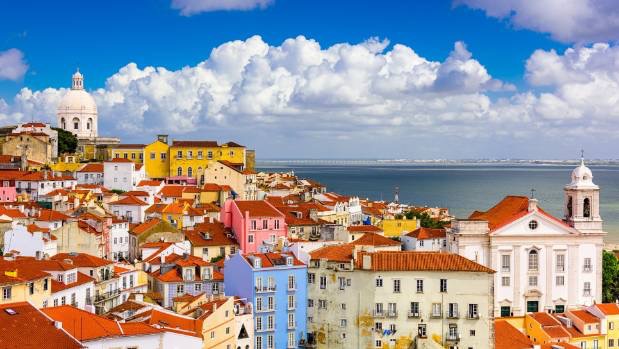
Text & photos by Marla Norman unless otherwise credited
Of course, 4½ days in Portugal is ridiculous. Not nearly enough time to experience the country. Mostly just long enough to fall in love and then endure the heartbreak of leave-taking. But life is filled with compromises. And something is better than nothing. Pick a cliché.
As it turned out, however, 4½ days was more than enough time to sort out what we would and wouldn’t do during the next visit. So, read on and profit from our experiences, fellow traveler.
SINTRA: CASTLE KINGDOM
We knew Portugal was the new “Destination Darling” when we booked our trip. But arriving at the Lisbon airport — jam-packed with tourists — confirmed that distinction immediately! Michel and I join the throngs and wait patiently (sort of) for our luggage….then wait for our rental car….wait to exit the airport….
Finally, we take off for Sintra. Visiting the outlying areas of Lisbon first was a good strategy. The twisty, winding roads to Sintra are lovely. And Lisbon’s bustling cityscapes quickly fade to thick forests. The distant blue of the Atlantic blends with cerulean sky.
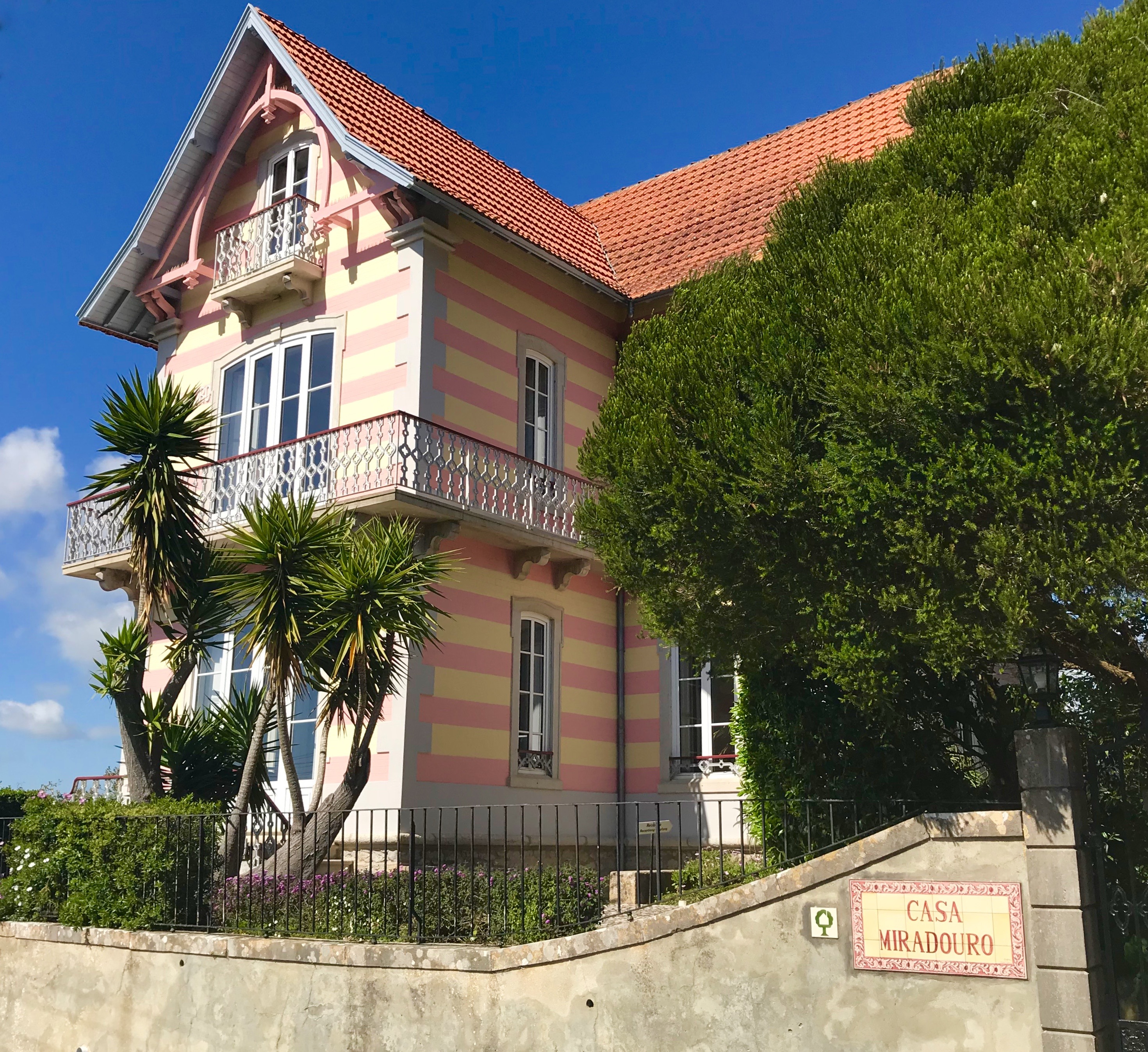
Casa Miradouro Bed & Breakfast in Sintra.
We continue up the charming zigzag roads in search of Casa Miradouro, our Bed & Breakfast. The GPS seems a bit confused. We most certainly are. After looping around the narrow streets three or four times, we stop in front of a large stucco building, brightly painted in pink and beige stripes — just like the photos on the website. A petite woman, noticing our multiple orbits around the property, waves us inside. Welcoming us into a pretty sitting room, she graciously pours us a glass of port.
As we collapse on the couches, our hostess points out the jaw-dropping views of the Douro River. We chat a bit longer, then she hands us the key to our room and a large card that reads: Estacionamento para hóspedes. “You must put this card in the front window of your car immediately,” she explains. “Hurry before the Police fine you or tow your car. And by the way, I’ll need to add €20.00 a night for the card.”
Surprised, we rush out and stick the card on the car window. Sure enough, as we turn to go back into the property, we see a police car slowly making its way up the road, checking for cars to ticket.
So…a bit of a bumpy start. Fortunately, our room is marvelous. The cost is a mere €120 a night. Of course, we now have another €20.00 per night for parking and an additional €20.00 for breakfast. The fees are starting to add up. But still, the views are stunning, the property charming. And, later that evening, as we walk to the nearby village for dinner, we spot one of Sintra’s many castles, the Palácio Nacional, white and gleaming up on a hill. Beautiful!
We wander the streets of the village and then on to the Restaurant Incomum. The chef-owner Luis Santos serves updated versions of classic Portuguese dishes. We share Ravioli filled with sweet potato and topped with shrimp, mussels and delicately fried seaweed — an unforgettable combination of flavors! For main courses we choose the Bacalhau Marinado and Duck with Tangerines and Truffle Risotto. Dessert is a rich chocolate-orange mousse. And of course, we finish off the evening with a glass of Port. How else would you expect to end the day in Portugal?
The following morning, we begin touring the castles. Sintra’s exquisitely lush forests were popular summer get-aways for the Portuguese aristocrats over the centuries. Many of the residences are now open to the public and have been classified as UNESCO World Heritage Sites.
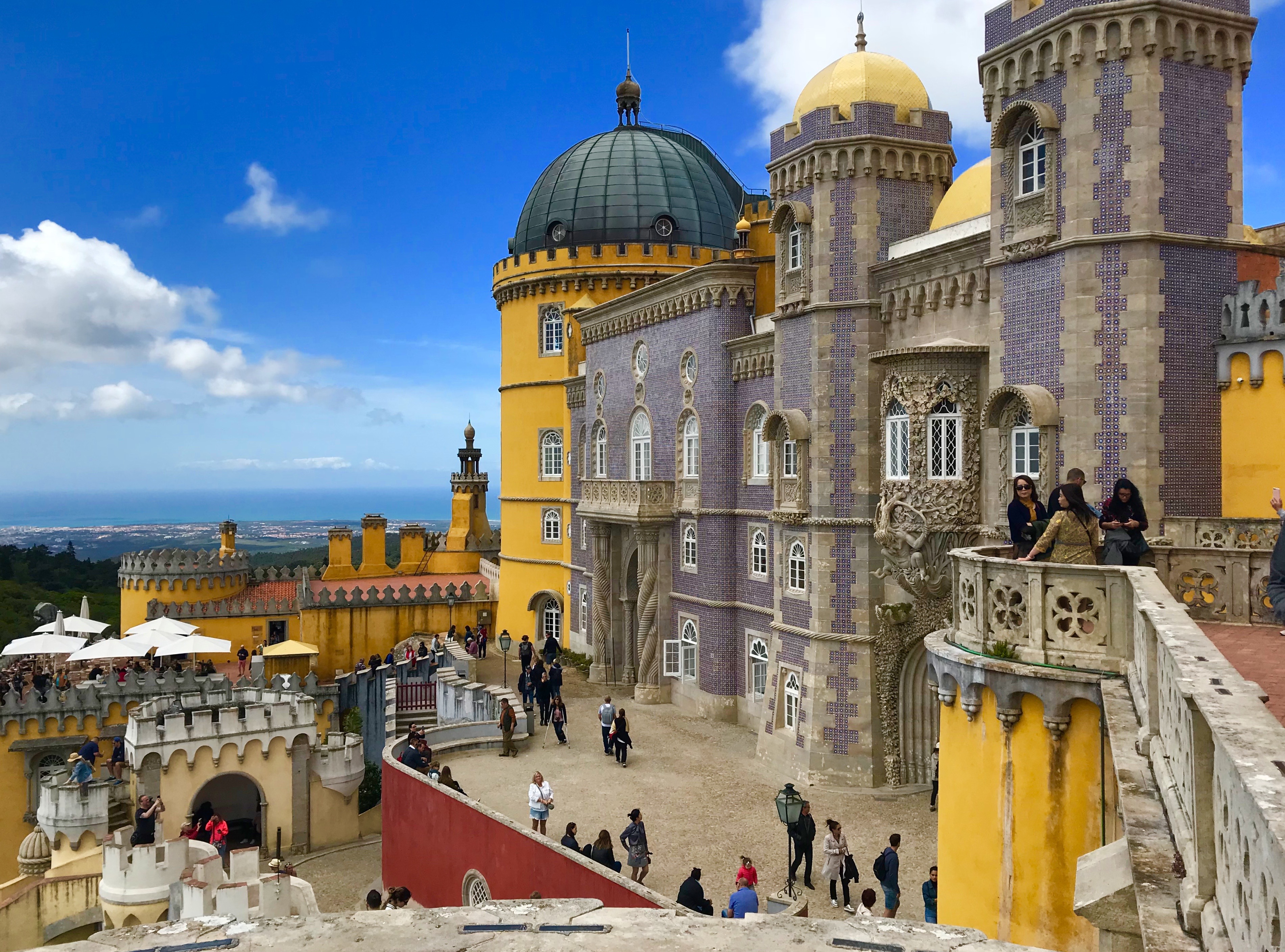
Palácio da Pena, with it’s lemon-colored towers and ornate turrets.
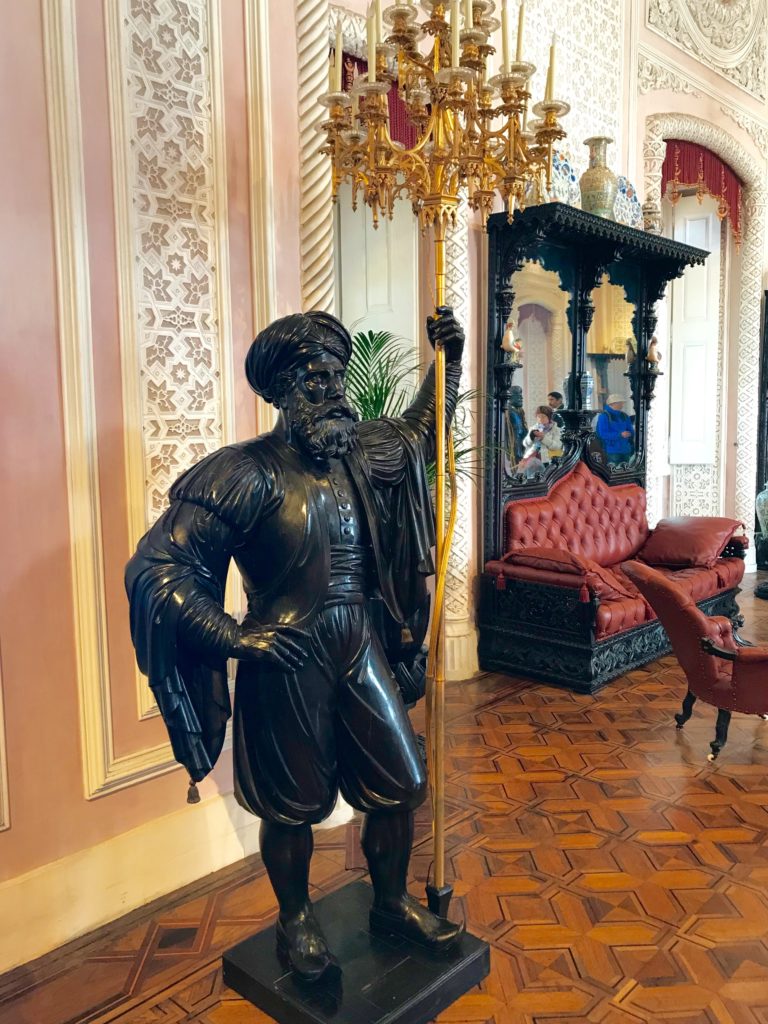
Lavish interiors at Palácio da Pena.
The Palácio da Pena is first on our list. We breeze up the narrow winding roads, thankful we’d rented a Mini Cooper. Anything much larger would get stuck. From several miles out we spot the brilliant lemon-colored towers and red turrets of the palace.
Ferdinand of Saxe Coburg-Gotha, the artist-husband of Queen Maria II began building his dream castle in 1840. The result is a unique blend of Victorian and Moorish architecture with a dollop of Ferdinand’s beloved Bavaria in the mix as well. The interiors are equally extravagant with heavy furniture and trompe l’œil murals. A large Meissen porcelain collection is one of the more impressive displays.
The palace sits on 12.35 acres (5 hectares) which include numerous gardens and walking paths. We make good use of the map provided at the entrance to explore small lakes, greenhouses and aviaries. The many rare plants and landscapes are astonishing. And the views again are remarkable.
Leaving the property we get a little lost, once more, on the twisty narrow roads. Somehow we wind up in an alley so tiny, even the Mini can’t squeeze through. We make a quick u-turn and suddenly a motorcycle policeman pulls up alongside us. “You made an illegal turn,” he yells. “Show me your driver’s license, passport and car registration.”
We can’t believe our bad luck and how irate the cop seems to be. “I need to give you a ticket,” he continues. “This will be expensive. At least €250.”
Michel gasps. I scream.
The cop nods. “I know. It’s a lot of money. Maybe I can do something. Follow me.”
He leads us to a more isolated parking lot. Michel has already pulled out his wallet and flashes €120 in cash. “Will this be enough? I don’t need a receipt,” Michel says, trying to swallow the sarcastic tone in his voice.
“That’s good!” answers the cop, snatching the money and jumping back on his motorcycle. I’m in shock. Michel is furious. Nevertheless, we take a few deep breaths and resume our castle adventure.
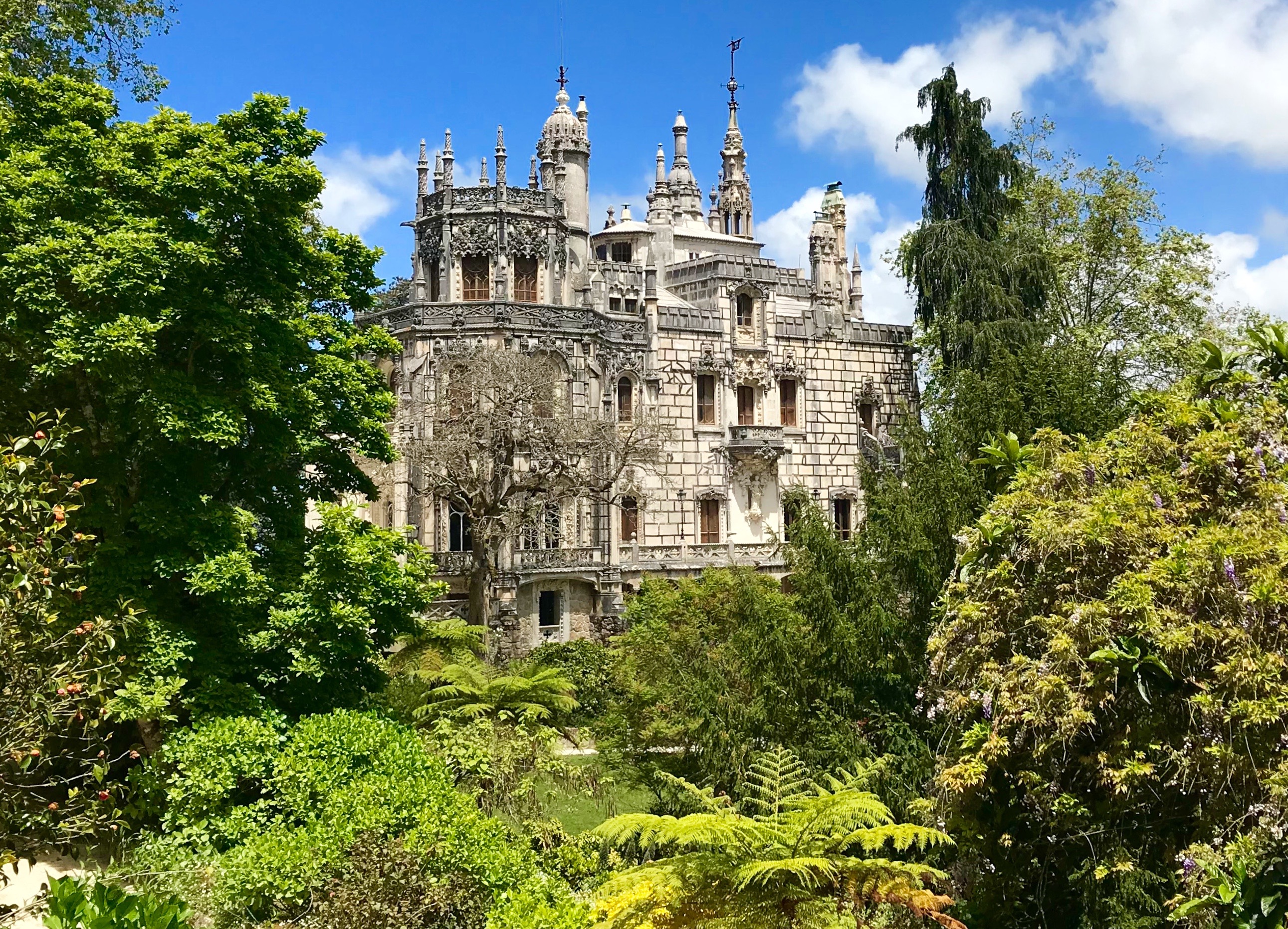
Quinta da Regaleira, owned by António Augusto Carvalho Monteiro, who was fascinated by the occult.
Quinta da Regaleira, situated within a deep forest, appears regal, but also gloomy-grey and forbidding. The estate’s primary owner was António Augusto Carvalho Monteiro, a wealthy Brazilian entrepreneur, who was fascinated with alchemy, Free Masons, Knights Templar and the occult in general. The haunted-looking Regaleira was clearly a perfect fit for his spooky hobbies.
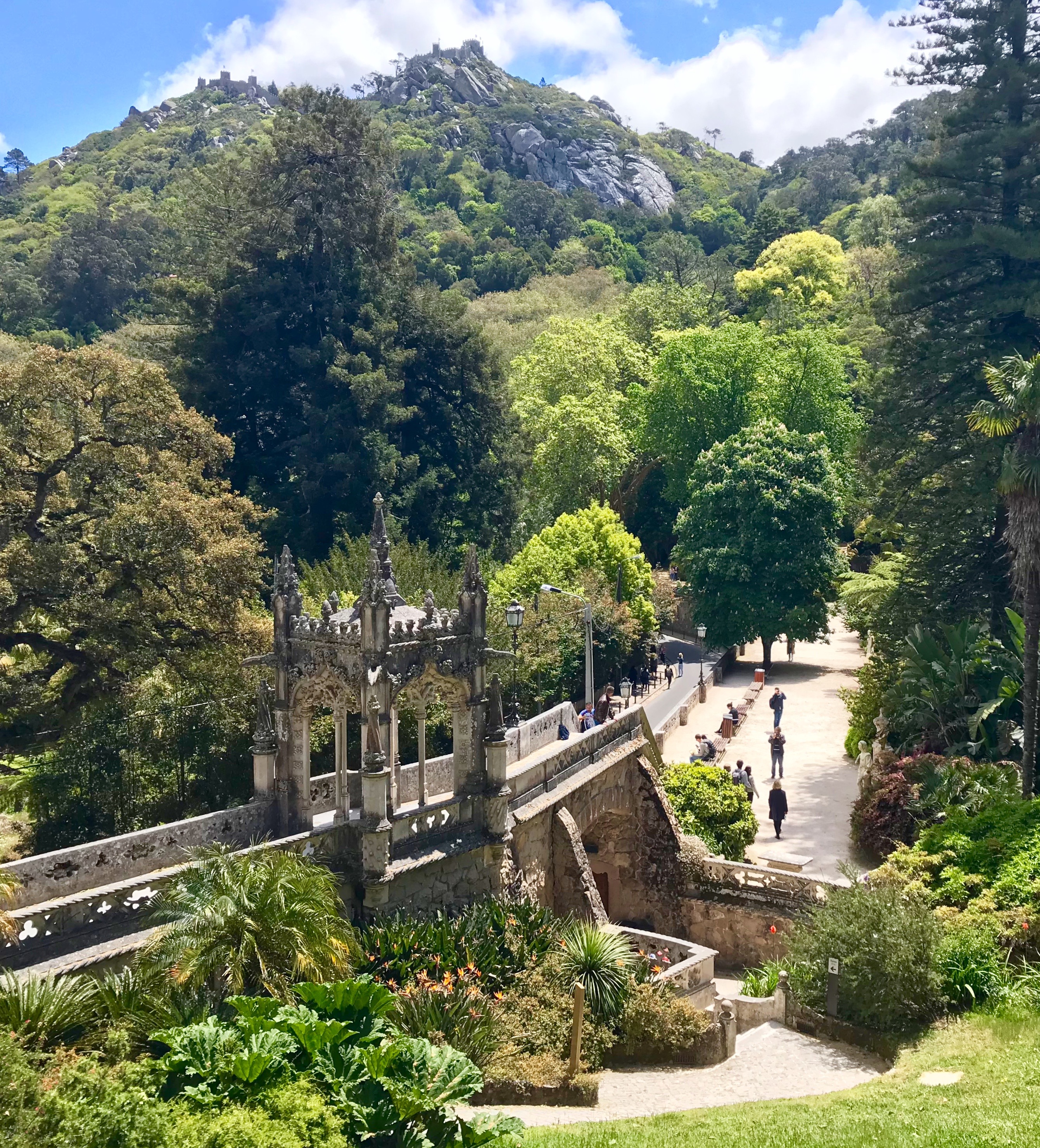
Elaborate gardens lead to a small chapel and underground tunnels.
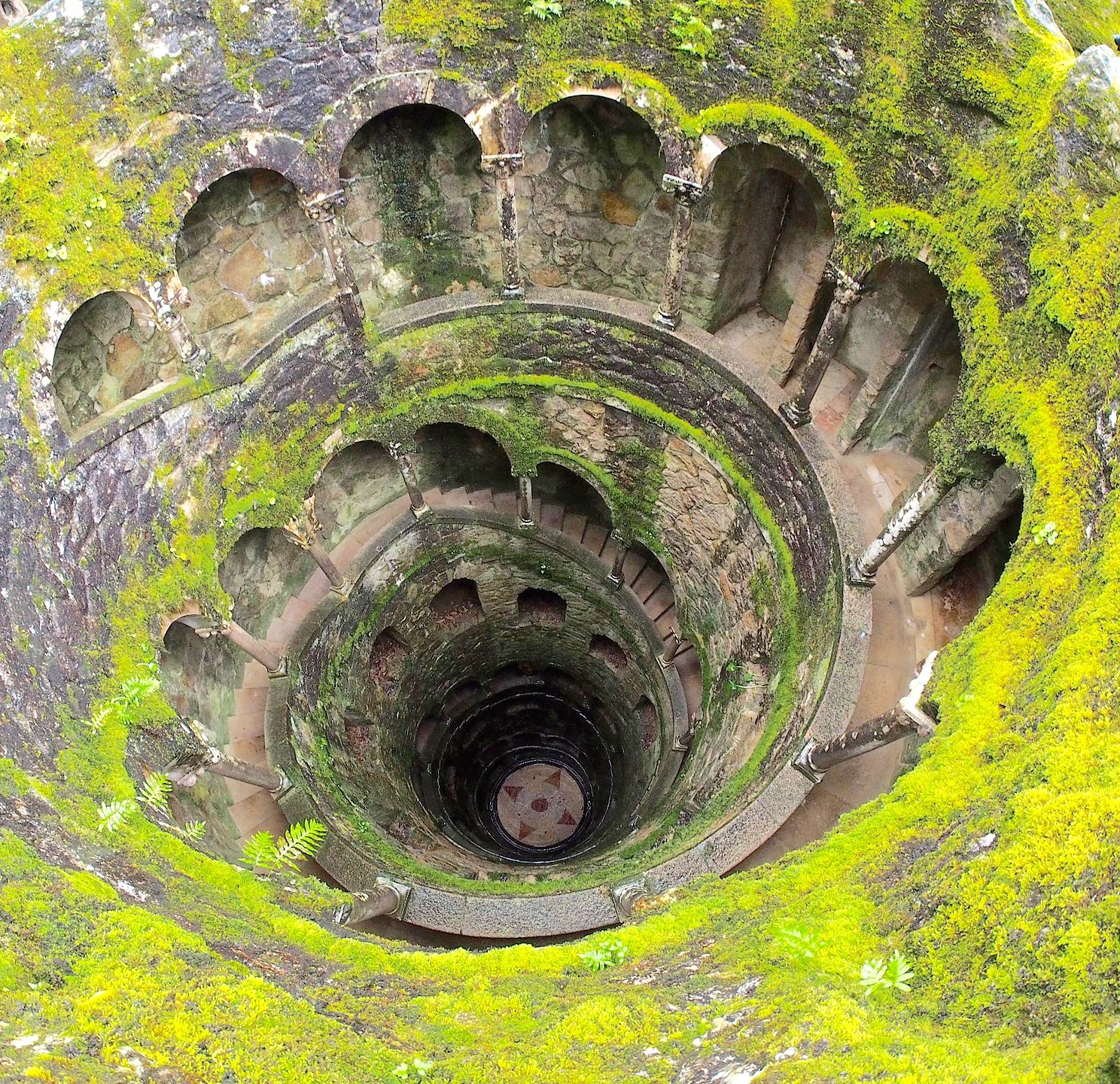
The Initiation Well — used for mysterious ceremonies.
The five-story palace is richly decorated with embossed ceilings, paneled walls and ornate fireplaces. The chapel is adorned with frescoes and stained glass windows. We’re intrigued by the extensive system of tunnels that runs under the estate property. There are grottoes, another chapel and a lake. Even more curious, is a site called the Initiation Wells, which have nothing to do with water, but are deep, walled pits with spiraling stairs running along the walls. Monteiro supposedly used the “Wells” for ceremonial purposes. Fascinating and more than a little creepy at the same time.
Our third castle stop is the Palácio Nacional, which sits high on a hill in the middle of Sintra. We circle around looking for parking. There’s none to be had. We drive back to Casa Miradouro and instead hire a Tuk-Tuk. Our driver provides a quick tour of the city as an extra bonus en-route to the castle.
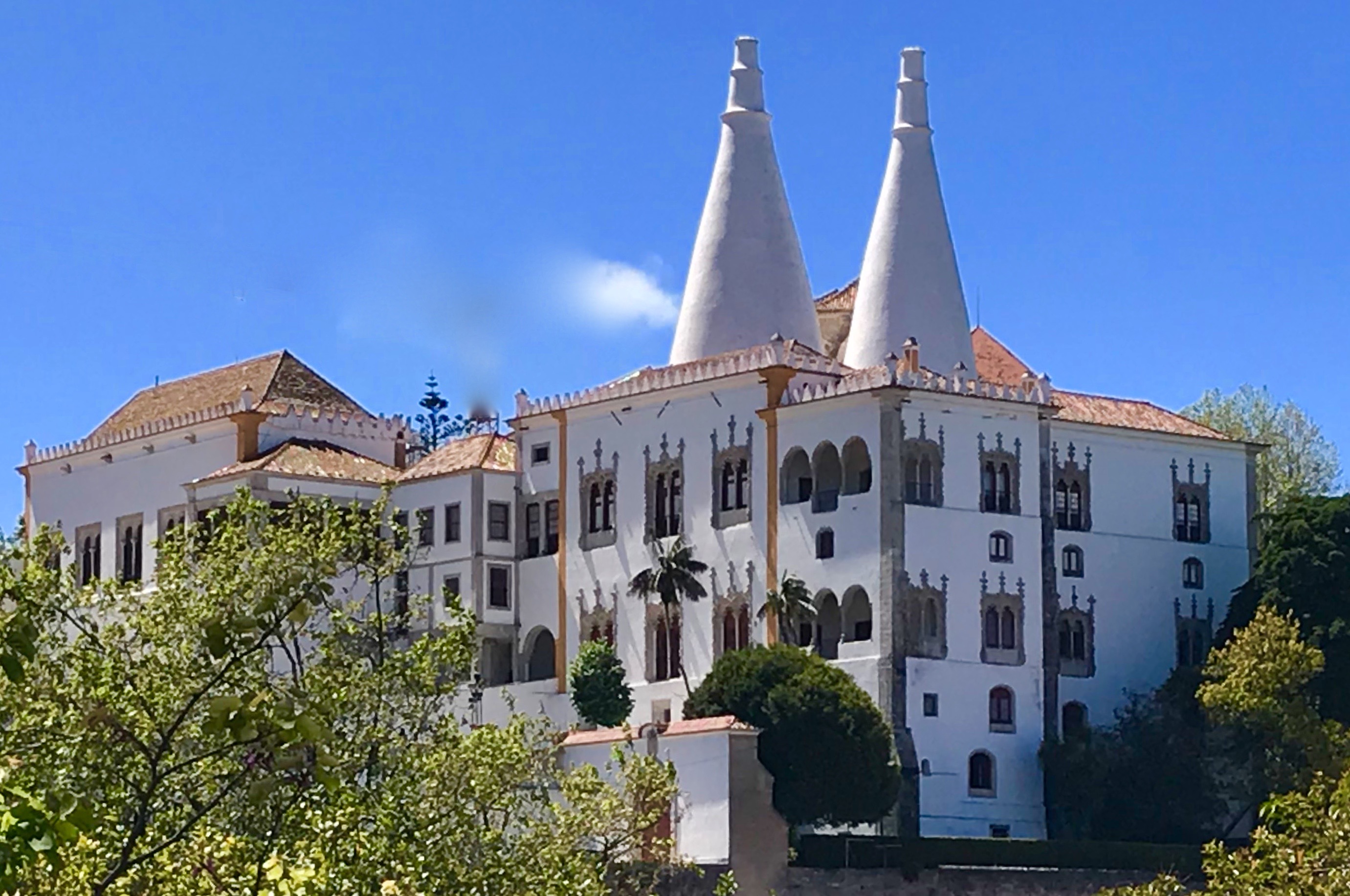
Sintra’s Palácio Nacional is the only surviving royal palace in Portugal from the Middle Ages.
Oddly, one of the oldest castles in Portugal is the most modern-looking. Massive and linear, two mammoth cones cap the building, making it seem as if it’s right out of a new-age, science-fiction landscape. But in fact, Palácio Nacional dates to the late 14th century and is the only surviving royal palace in Portugal from the Middle Ages. Moorish, Gothic and Manueline architecture are evident in the structure. The huge cones are an ingenious method for venting the kitchen, constructed by João I in the 15th century.
King João I also commissioned the Impressive Sala dos Cisnes (Swan Room), with 27 frescoes of gold-collared swans. Equally splendid is the Sala das Pegas (Magpie Room), entirely covered with 136 chattering birds. Each of the Magpies supposedly represents one of the Queen’s ladies-in-waiting, gossiping about the King’s flirtations — which of course he adamantly denied.
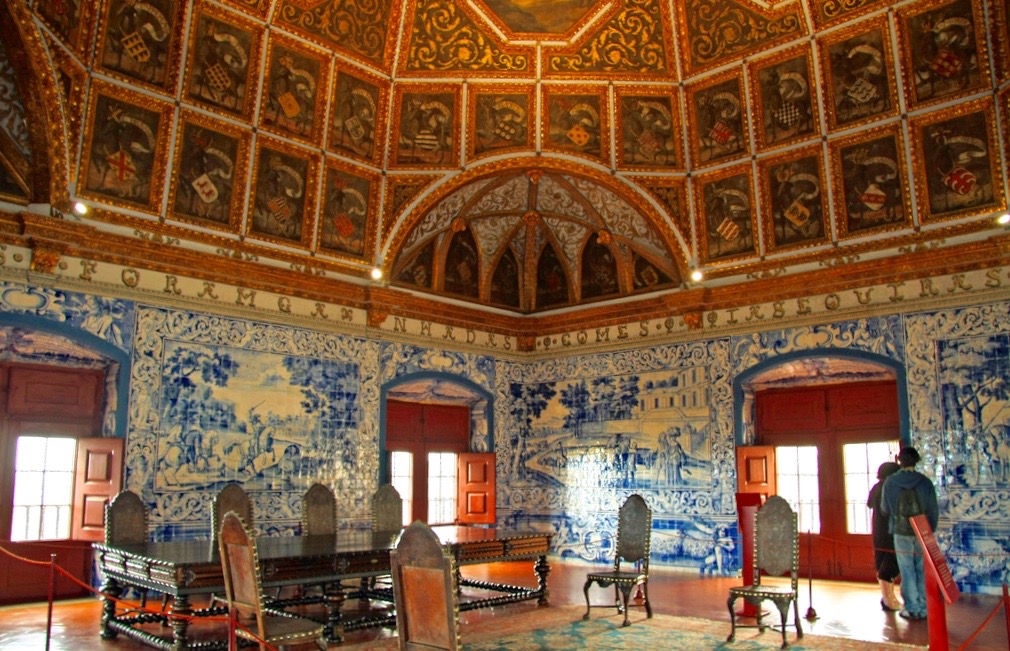
Sala dos Brasões (Coat of Arms Room) with wall-to-wall tile work. Photo courtesy of the Palácio Nacional.
The Sala dos Brasões (Coats of Arms Room) displays the shields of the 72 noble families in 16th century Portugal. An incredible portrait gallery! The room is also decorated with wall-to-wall azulejos, installed during the 18th century. It’s our first look at the massive tile installations Portugal is famous for — and we are bedazzled. More wondrous tile mosaics are featured in the Palatine chapel.
After touring the exceptional Palácio Nacional, we feel as if our senses have been elevated to a new dimension. To completely soak up the experience, we take a long, slow walk back to Casa Miradouro. As we stroll along, the sun sets over the river. Shimmering colors blast the sky. Lights come up in the village and reflect within the dense woods. The English Romantic poets were infatuated with Sintra, even Lord Byron lived here at one point. Now we know why.
PORTO: PRETTY & POSH
Early the next morning, we zoom up to Porto. The main highway uniting Lisbon and Porto is excellent and takes approximately 3 hours to drive. We would have preferred the coastal highway, but since that would require at least 8 hours — with lots of temptations to stop — we reluctantly choose the quicker route. After all, we have only 3 days left….
In Porto, we check into Hotel Porto Palácio, a 5-Star property, with rates of €250 per night. The rooms are splendid. A valet has whisked our Mini into hotel parking. We’re sipping Champagne with the concierge to figure out our next move. Not bad so far!
The Porto Palácio is located just north of Porto’s historical district — where most tourists want to visit and stay. We purposely chose a hotel popular with business travelers, away from touristic sites. But we want to visit the historical area, so we map out places we most want to see. Not surprisingly, the Concierge mentions that traffic and parking are impossible in the Old Town. We grab a taxi, for a quick 20-minute ride.
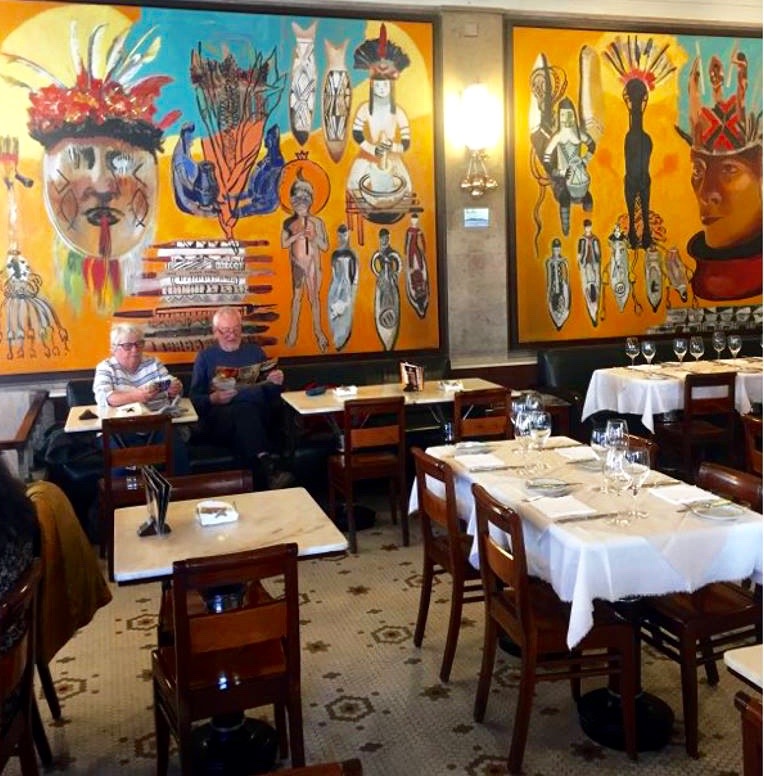
Afro-Brazilian murals at Café Guarany, one of Porto’s oldest restaurants. Photo courtesy of Guarany Café.
Our first stop is Café Guarany. One of the oldest restaurants in Porto, Guarany has been open since 1930, when it was a meeting place for local writers, musicians and intellectuals. The restaurant has gorgeous tiled floors, marble-top tables and Afro-Brazilian murals. Efficient waiters in starchy white jackets make service seem effortless.
We order plates of Pata Negra Ham, Polvo Ceviche and Picanha à Guarany (Grilled beef served with white rice, fries, pineapple, black beans and cabbage). Guarany has long been famous for its excellent coffee and hot chocolate — hence the references to Brazil. In the evening, the restaurant hosts Fado Nights (original Portuguese music), debates and poetry readings. Unfortunately, we have just enough time for a cup of the renowned coffee.
Porto’s historical center is particularly significant. Unlike Lisbon, which was destroyed in an earthquake in 1755, Porto was left untouched. The city has a number of well-preserved baroque buildings. We start our walking tour at the Praça do Município (City Hall) located just across the street from Guarany Café – a strikingly elegant building, it’s also quite new, completed in 1957.
Since we discovered Azulejos in Sintra, we’ve been eager to see more. The São Bento Railway Station provides a marvelous opportunity, with over 20,000 tiles painted by Jorge Colaço, one of Portugal’s most beloved artists.
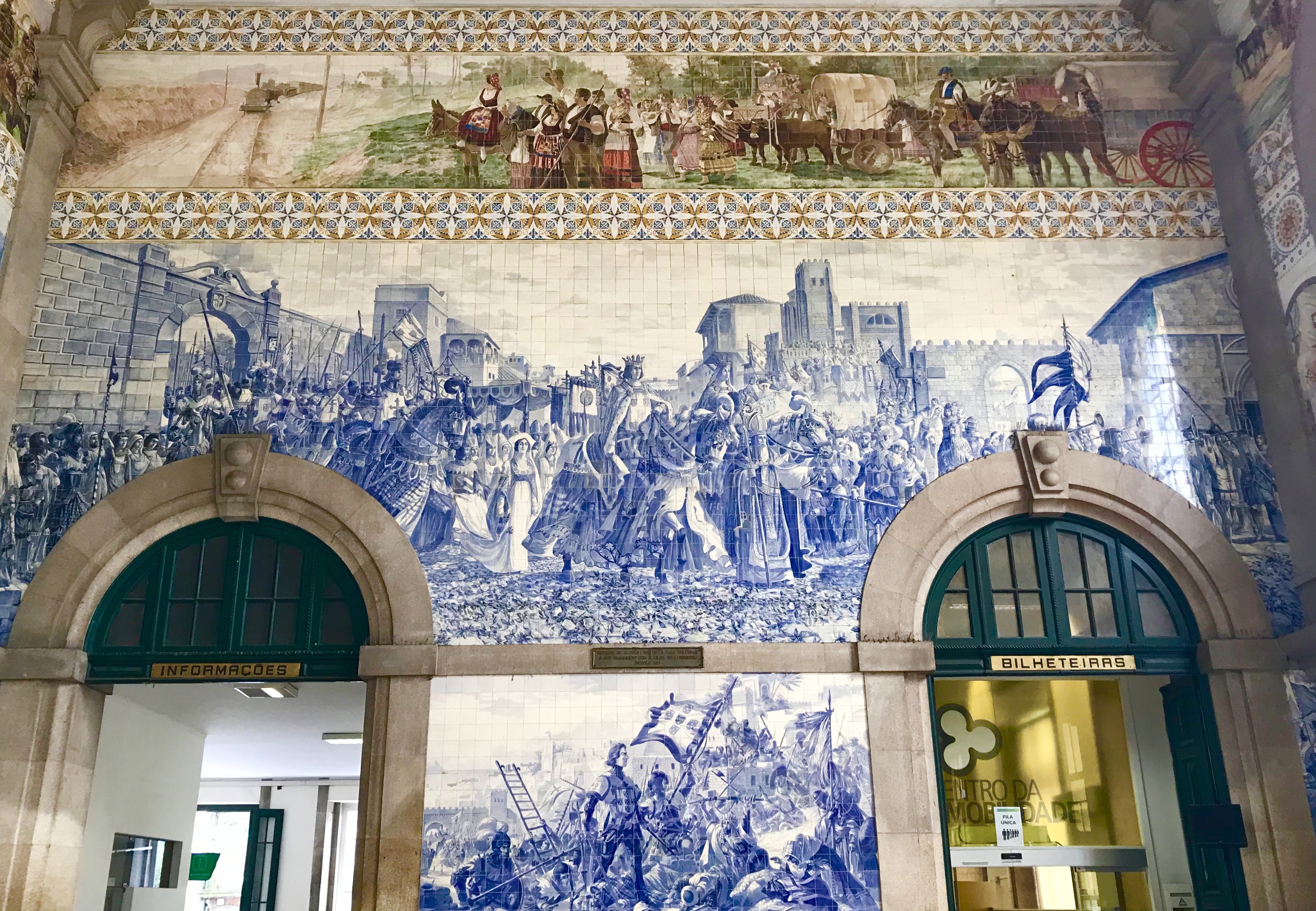
São Bento Railway Station with over 20,000 azulejos. This wall depicts the wedding of King João I. .
Most of the walls depict significant Portuguese battles; smaller panels portray romantic scenes of the countryside. Especially spectacular is a mural of King João I and his English Queen Philippa of Lancaster as they enter Porto to celebrate their wedding.

Igreja de Santo Ildefonso displays some 11,000 tiles depicting the Gospels. Photo by Marla Norman.
Nearby, Igreja de Santo Ildefonso (Church of Saint Ildefonso) is utterly breathtaking — another extraordinary example of Azulejo tile work and, again, Jorge Colaço’s artistry. The church exterior is covered with some 11,000 blue and white tiles depicting scenes from the Gospels and the life of Saint Ildefonso. The Baroque church dates back to 1739. Colaço completed the façade in 1932.
Mass is held daily at the church and well attended by locals, as well as tourists looking to see the gilded altarpiece by 18th-century Italian artist Nicolau Nasoni.
Igreja dos Clérigos, one of the first Baroque churches in Portugal, was also designed by the prolific Nicolau Nasoli, who is interred here as well. The monumental tower is 249 feet high. We climb (slowly) the 225 steps to the belfry. It’s a good workout, but we’re thrilled with the views of the Old Town and the Douro River.
By the time we climb back down the tower, we’re ready for a break. We find another cute cafe, order a bottle of Alvarinho Vinho Verde and enjoy the surroundings.
PORT: MAGICAL ELIXIR
Porto is, of course, most famous for the wine named after the region. The city’s main source of revenue is the vinification, storage and commercial shipping of port. The vineyards themselves are north of the city in the Douro Valley, the oldest wine appellation in the world.
No visit to Porto would be complete without a stop at Vila Nova de Gaia, where most of the port producers have offices and tasting rooms. Graham’s, Sandeman, Taylor’s, Niepoort and Ramos — to name just a few — are all there.
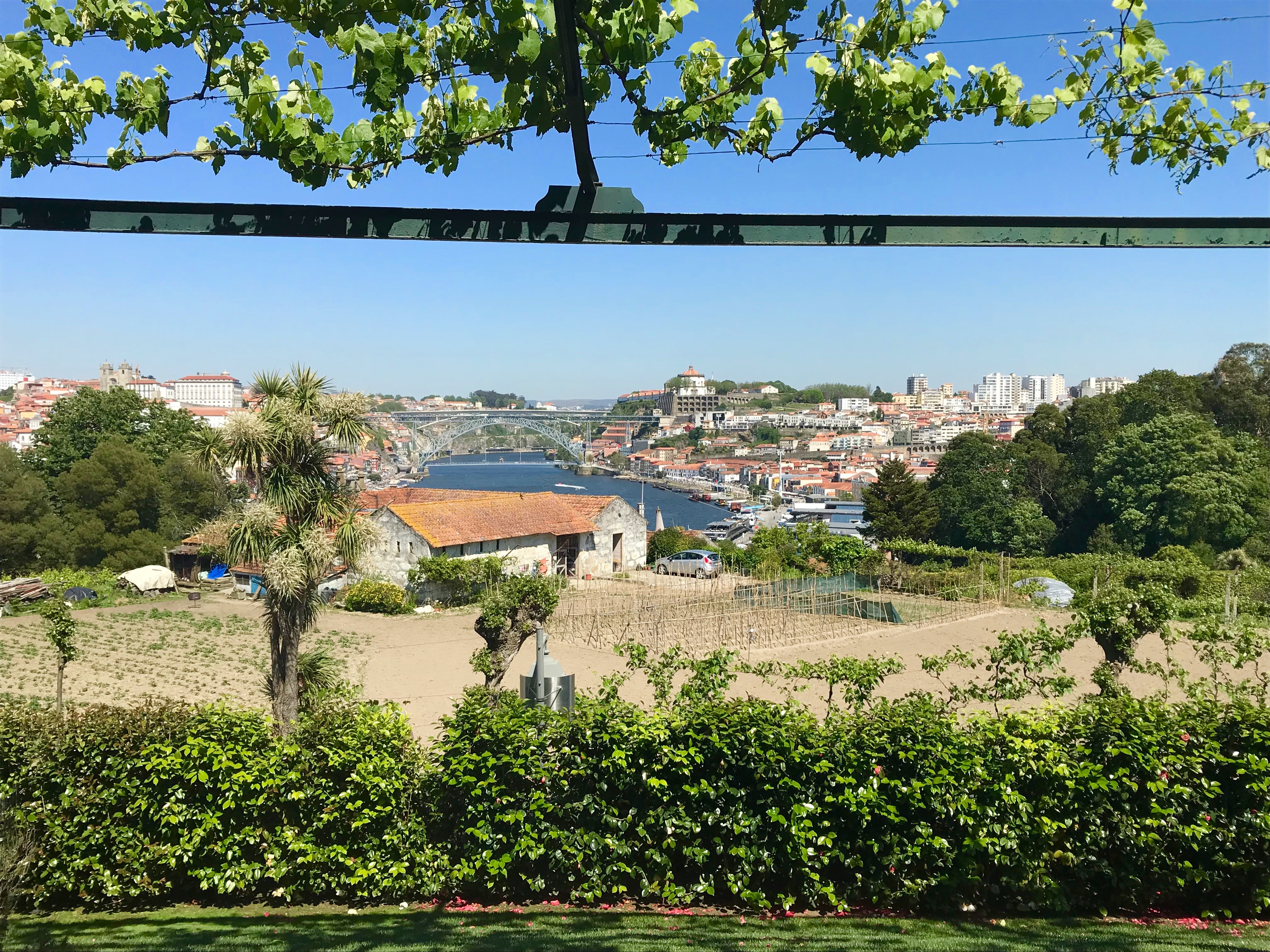
Views of Porto from the terrace of Vinum Restaurant at Graham’s Cellars. Photo by Marla Norman.
We’ve been invited by Graham’s Port to visit their facility at Gaia. Arriving early for our 10:00 a.m. appointment, we’re relieved to see plenty of parking — and it’s free!
Graham’s Museum chronicles the history of the family operations beginning in 1890. Among the many fascinating documents are invoices to Winston Churchill, a devoted client of Graham’s Ports, and letters from Queen Elizabeth II. The cellars house recently harvested port as well as older vintages. Even the original 1882 barrels are on display. Two precious barrels remain.
After touring, we join Euan Mackay, Commercial Director at Graham’s, in the property’s private club, The Vintage Room. While chatting with Euan, we sample the Six Grapes first, then the 2000 Vintage Port and move on to a number of Tawnies — 10-year old, 20-year old and 30 year-old. The 20-year old is far and away our favorite. It combines beautiful fruit and an incredible balance of sweetness and acidity with perfect aging.
Lunch at the property’s Vinum Restaurant & Wine Bar is another treat. The terrace and panoramic views of Porto and the Douro River make for a spectacular setting. Euan mentions that evenings are even better, when the medieval and baroque buildings in Porto’s Old Town are beautifully lit up.
The Vinum menu features traditional Portuguese cuisine with an upscale approach. We feast on Ham Croquettes, Fried Squid and Alheira de Mirandela (Portuguese bread & meat sausage) grilled with peppers. The main course is a sumptuous Hake, beautifully served table side.
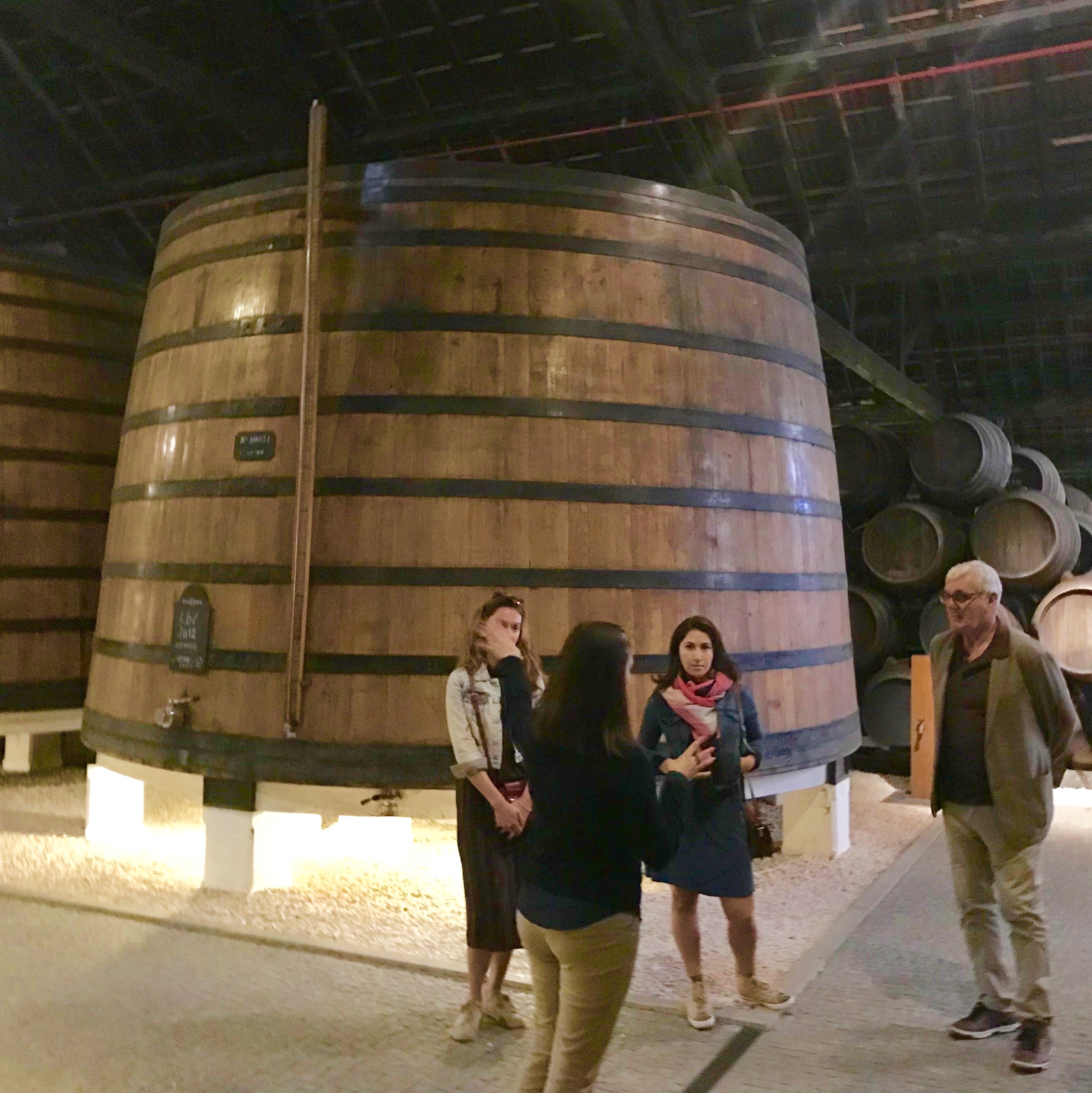
Touring Graham’s Cellars. Photos by Marla Norman.
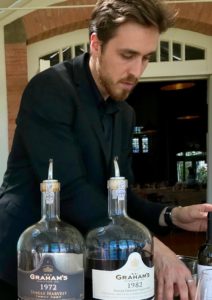
Tasting Graham’s 1972 Single Harvest Tawny and the newly-released Graham’s 1982 Single Harvest Tawny, commissioned by Queen Elizabeth for the recent royal wedding.
Wines accompanying the meal are a 2016 Altano Nautralment Reserva and a 2016 Post Scriptum de Chryseia, both from Symington Family vineyards in the Douro. The white Altano is crisp, fresh and clean. The red Post Scriptum has a New World edge, with dense, compacted fruit, rich and elegant.
As a grand finale, we are treated to Graham’s 20-year Tawny, the 1972 Single Harvest Tawny and the newly-released Graham’s 1982 Single Harvest Tawny, commissioned by Queen Elizabeth for the recent royal wedding of Prince Harry and Meghan Markle. Quite a finish to an already extraordinary meal!
PETISCOS & ESPUMANTES
The Boavista neighborhood near our hotel is an especially vibrant area. After a bit of exploring, we pop into the Mercao Bom Sucesso for a few tapas, or petiscos as they’re called in Portuguese. The two-story building is filled with small specialty shops selling everything from charcuterie to jewelry and clothing. Food kiosks offer creative sandwiches, risottos, bites of fish, pork and assorted goodies.
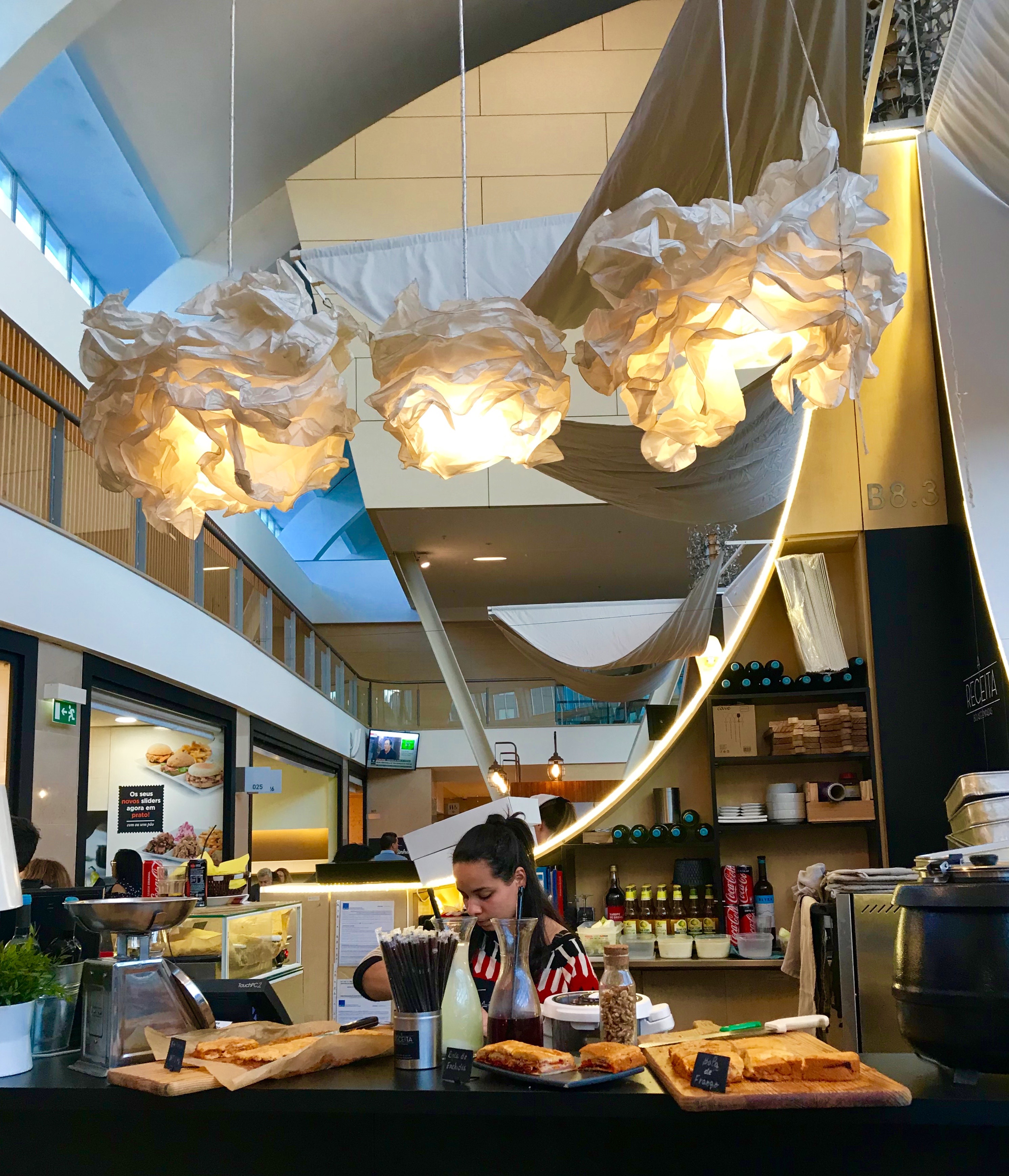
At Mercao Bom Sucesso, food kiosks offer delicious Portuguese Petiscos.
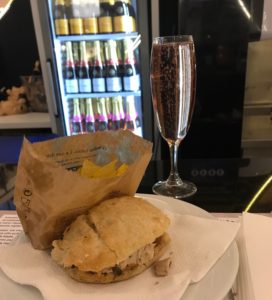
Leitão do Ze at Mercao Bom Sucesso serves up pork sandwiches and espumante.
At the Mercao, we chat with locals, most of whom speak perfect English. They offer suggestions for additional petiscos and Portuguese wines. Following their advice, we visit Leitão do Ze where we indulge in a luscious pork sandwich, accompanied by house made potato chips and a glass of espumante — Portuguese sparkling wine. Maravilhoso!
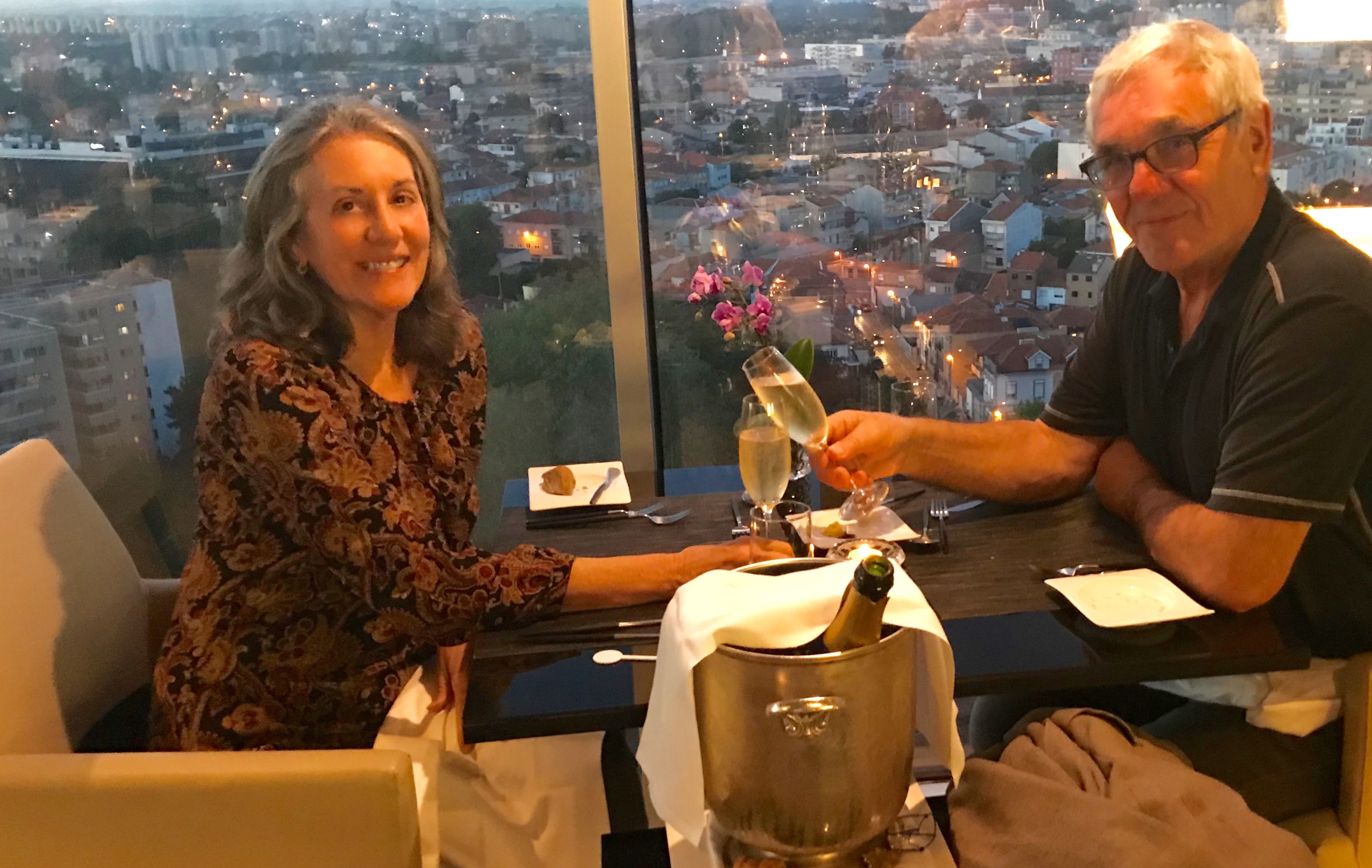
High above Porto, at the rooftop terrace of Hotel Porto Palácio, Marla & Michel toast the city.
Later, we take advantage of the rooftop terrace at Hotel Porto Palácio. The views of the city are thrilling. Lights glitter for miles. Ships slowly move up and down the Douro. On this noite passada (last night), we make our farewells to Porto, promising to come back soon.
LISBON AT LAST
Early the next morning, we drive to Lisbon. It’s our last full day and the only time we have devoted to the capital — a city over 3,000 years old with dozens of world-class museums and historical sites. Crazy to think we’ll see much. But we’re determined to make the most of every second we have.
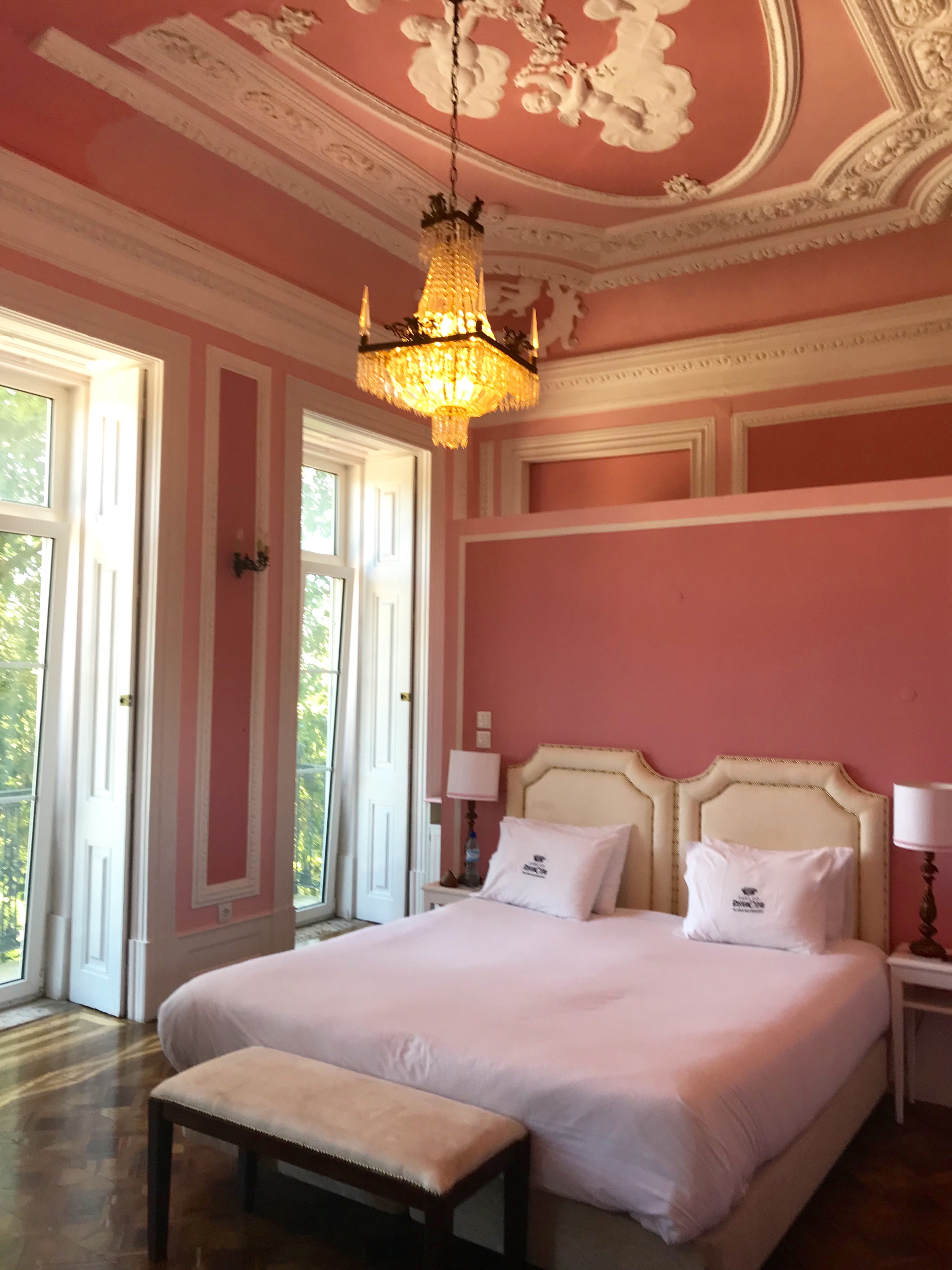
Exceptionally pretty rooms at the Casa do Príncipe B&B in Lisbon.
We make good time flying down the highway….until we reach Lisbon. Traffic is heavy and interminably slow. We watch the minutes tick away as we creep along. Eventually we reach the Príncipe Real neighborhood and our B&B, Casa do Príncipe. The property is located directly in front of the National Botanical Gardens, a 10-acre park with over 18,000 species of plants. More greenery is just across the street at Praça do Príncipe Real (Royal Prince Park). In addition to enormous trees and tropical plants, beautifully preserved buildings line the streets. The area couldn’t be lovelier.
Our room has two sets of French doors opening onto a balcony overlooking the National Botanical Gardens. It’s painted a dreamy shade of pink with gorgeous parquet floors and a chandelier. Most impressively, angels in bas-relief float on the ceiling over the bed. It’s simply breathtaking — and only $162 a night.
Parking however (of course) is a problem. The manager explains that there is private parking available, but it’s 8 blocks away. We dump off our luggage and dash back out.
Another 30 precious minutes later, we’re parked and hailing a taxi to take us to Belém, one of the oldest neighborhoods in Lisbon. En route, our driver passes by the Castelo de São Jorge (St. George’s Castle) so we can at least marvel at the oldest castle in the city. The sprawling fortress is visible for miles.
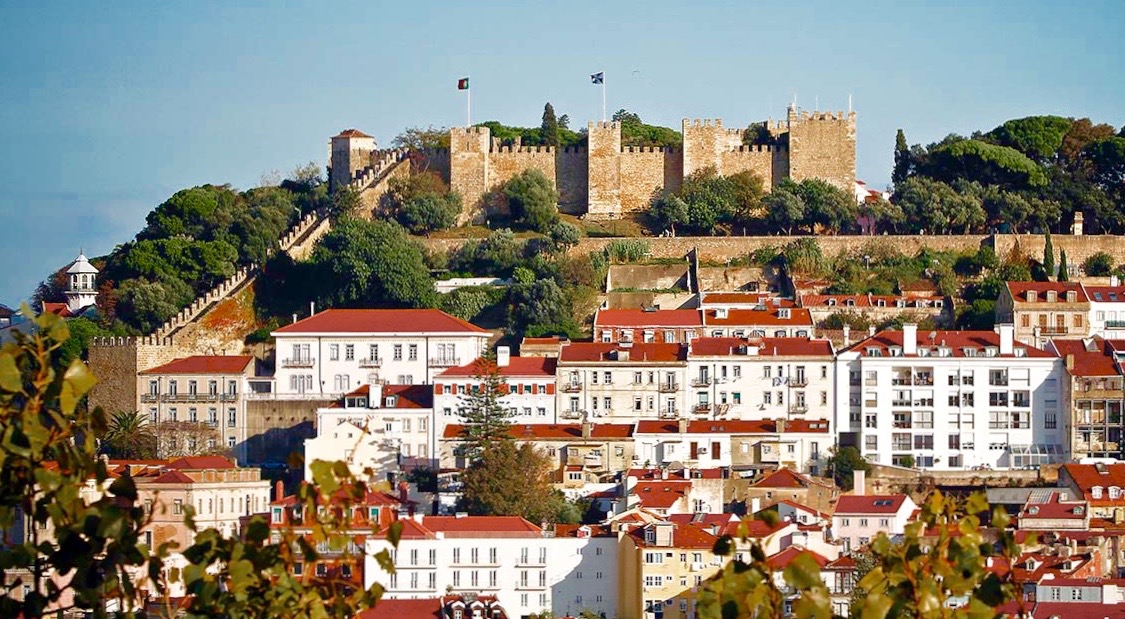
Castelo de São Jorge, Lisbon’s oldest castle, sits high above the city. Photo courtesy of Museu do Castelo de São Jorge.
Celtic tribes, Phoenicians, Greeks, Carthaginians, Romans and Moors have all occupied the castle, on a hill strategically overlooking Lisbon. During the Christian Reconquista, in 1147, Crusaders captured the site and renamed it for Saint George. The castle was renovated in 1300 and much of the original Moorish construction was demolished. However, recent archeological digs have uncovered homes constructed by the Moors, as well as Roman houses. What stories those ancient walls could tell!
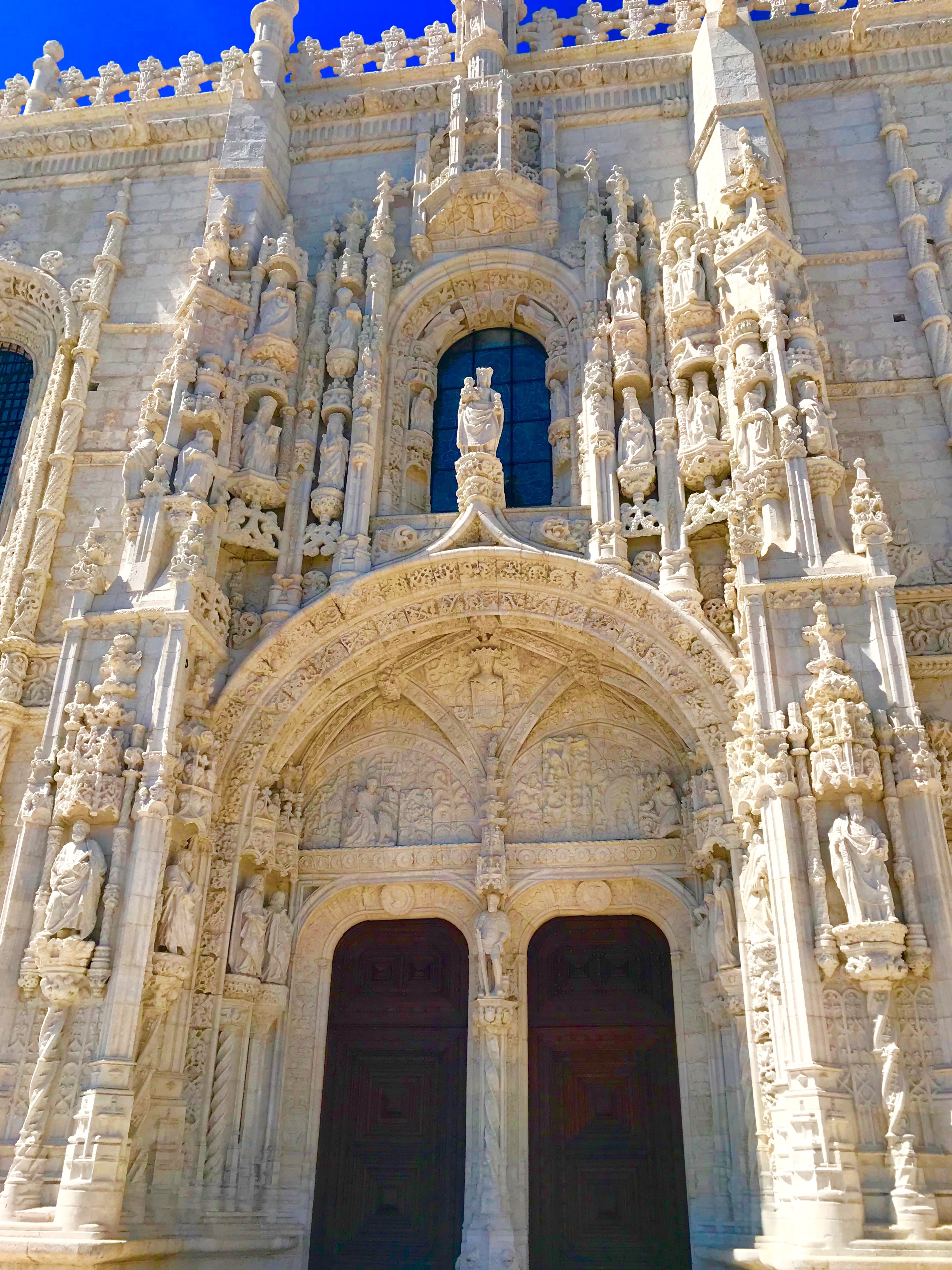
Impressively ornate entrance at Mosteiro dos Jerónimos. Photo by Marla Norman.
In Belém, our driver drops us off in front of the Mosteiro dos Jerónimos (Jerónimos Monastery) another vast, historical site, dating back to 1501. A UNESCO World Heritage Site, the monastery is one of the best executed examples of Manueline architecture. The incredibly ornate structure is covered with hundreds upon hundreds of sculptures, columns, decorative emblems, and insignias — so many faces and creatures, the walls almost seem alive. Amazingly, we’re able to spot the statue of Dom Henrique, o Navegador (Henry the Navigator), the brilliant mastermind of Portuguese exploration and trade.
Within the church, delicate latticework creates an extraordinary canopy across the ceiling. Portuguese explorer Vasco da Gama rests in a corner, as hundreds of tourists troop by. We had hoped to visit the historic gardens and architectural wonders, but a long line of visitors is queued up at the entrance.
Disappointed, we exit, searching now for a quick bite before resuming our tour. But more lines await at nearby restaurants. We grab another taxi instead, and ask to be taken to the Museu Nacional do Azulejo (National Tile Museum). We luck out. There are no lines and we walk right in.
Housed in what was once the Madre de Deus convent, the Museum contains room after room of exquisite tiles — contemporary works of art, as well as earlier Moorish geometrical designs.The most spectacular display is a 118 foot-long panel portraying Lisbon before the earthquake. The tiles, considered to be the largest work of its type in the country, are a detailed study of the city and waterfront circa 1730.
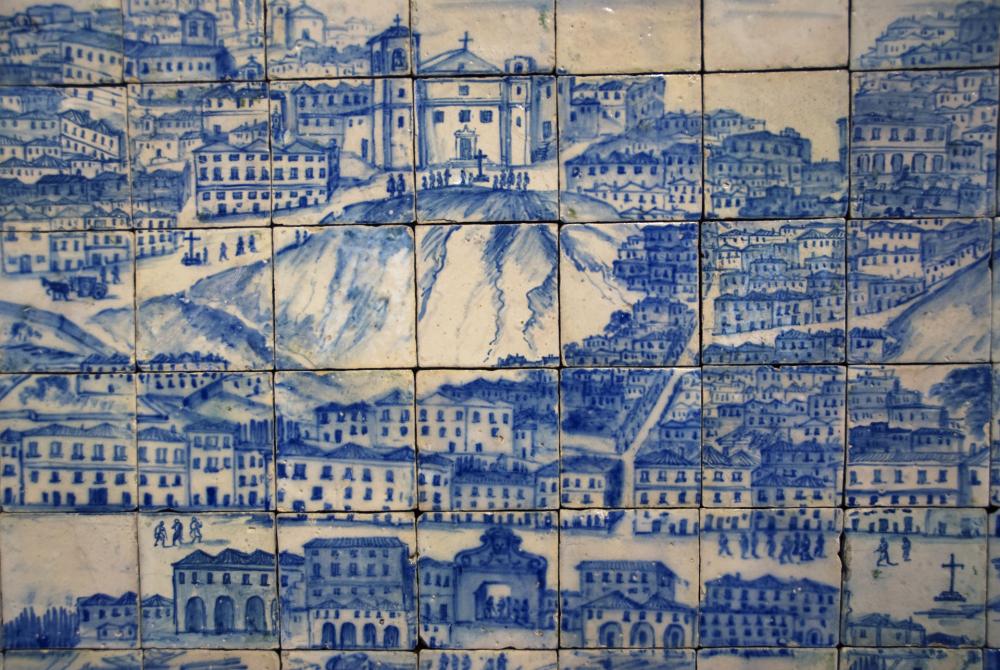
Azulejos depicting Lisbon before the 1755 earthquake. Photo courtesy of the Museu Nacional do Azulejo.
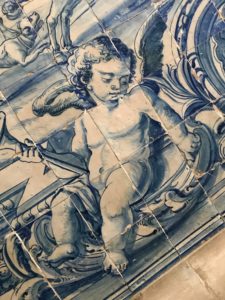
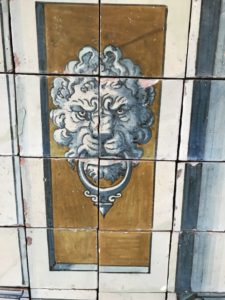
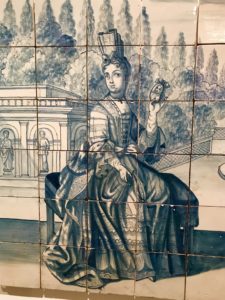
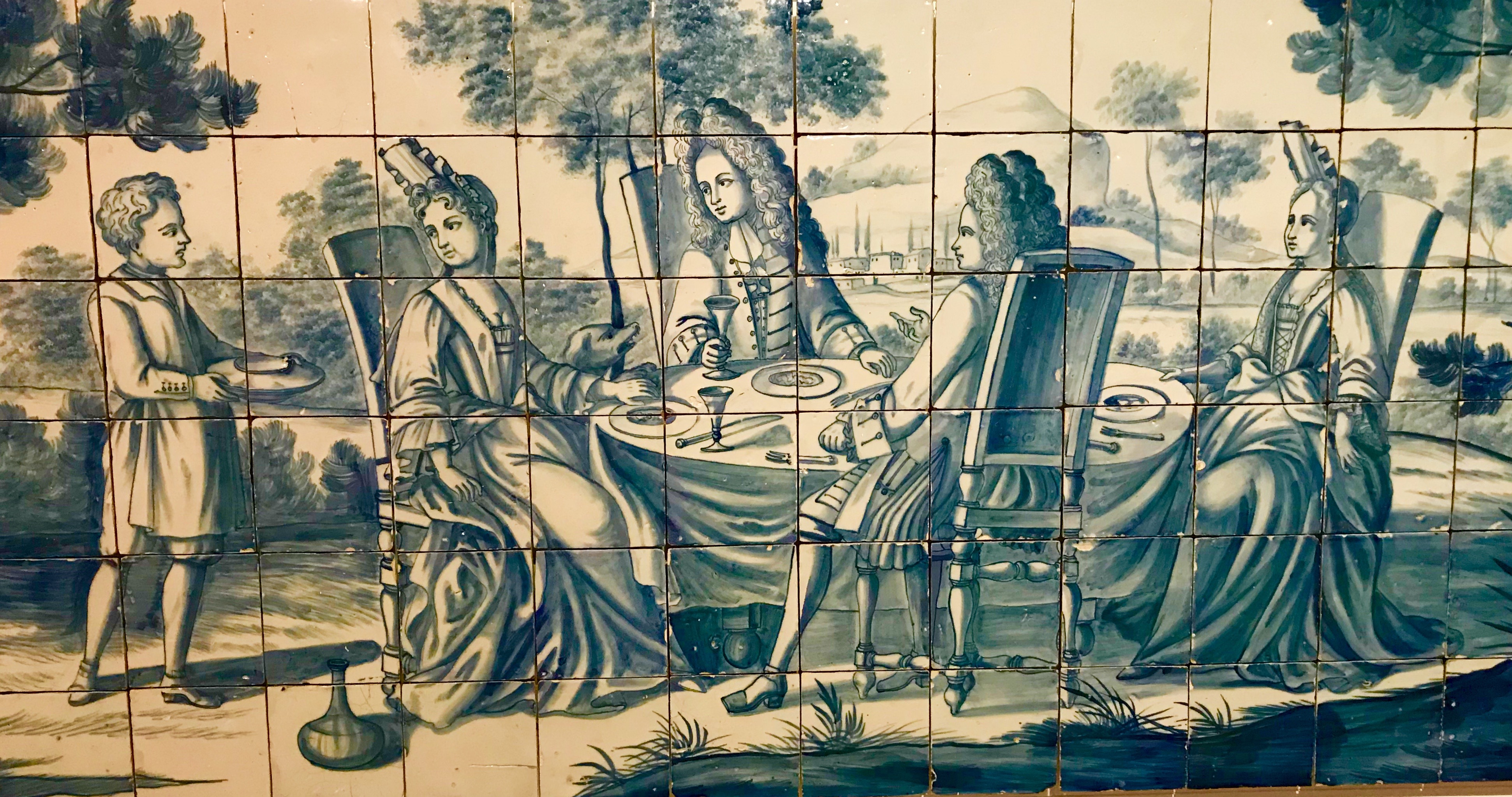
Museu Nacional do Azulejo display hundreds of exquisite tiles collected over decades.
A small chapel proves to be an additional wonder. Covered in gold, the gilded space is a dazzling reminder that Portugal was once an imperial power, ruling the world with extraordinary treasure derived from the Americas.
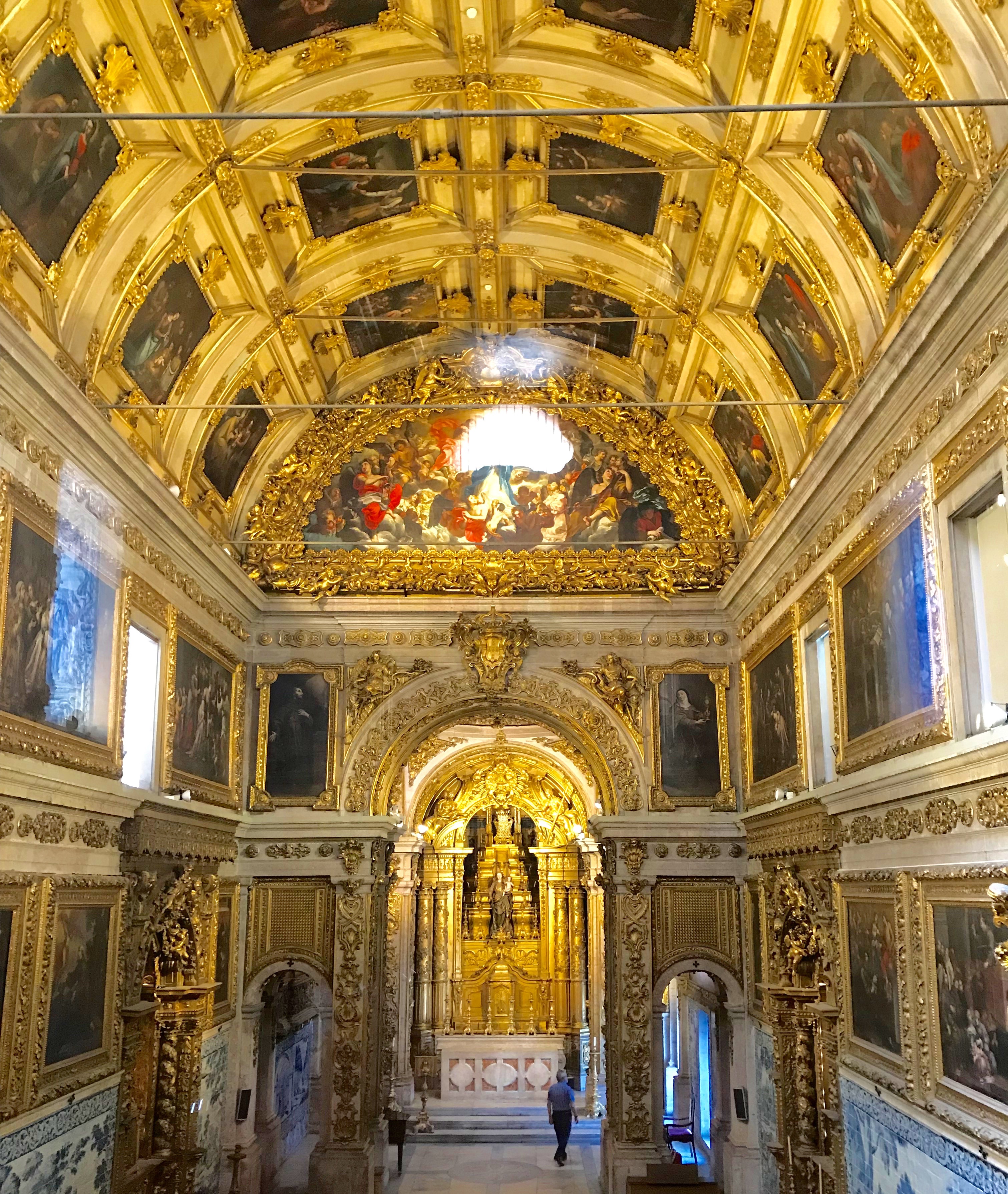
Madre de Deus Convent Chapel at the Museu Nacional do Azulejo. Photos by Marla Norman.
The chapel and old convent are peaceful and meditative — especially welcome after the crush of tourists we’ve experienced since arriving in Lisbon.
The sun is beginning to set by the time we get back to our B&B. Noticing an animated crowd and live music at the Praça do Príncipe Real, we join in. A tiny kiosk is selling cocktails and sandwiches. We gobble up a few plates with frosty beer. Friendly locals invite us — in perfect English — to share their park bench.
Our novos amigos recommend a restaurant just across the street from the park in the Ribeiro da Cunha Palace (also known as the Embaixada). Another Moorish architectural gem, the palace was once owned by the ambassador to Macau. Astounding oriental treasures collected by the ambassador still make for eye-popping decor.
We find a seat at Restaurant Less, where Chef Miguel Castro Silva creates a variety of luscious appetizers and small plates. Our waitress, Carolina, is a vivacious charmer, recently arrived from Rio de Janeiro. We order everything she suggests: Sea Bass Tartar, Lemon Risotto, Scallops, Pumpkin Ravioli and Iberico Pork Dumplings. Every bite is heaven!
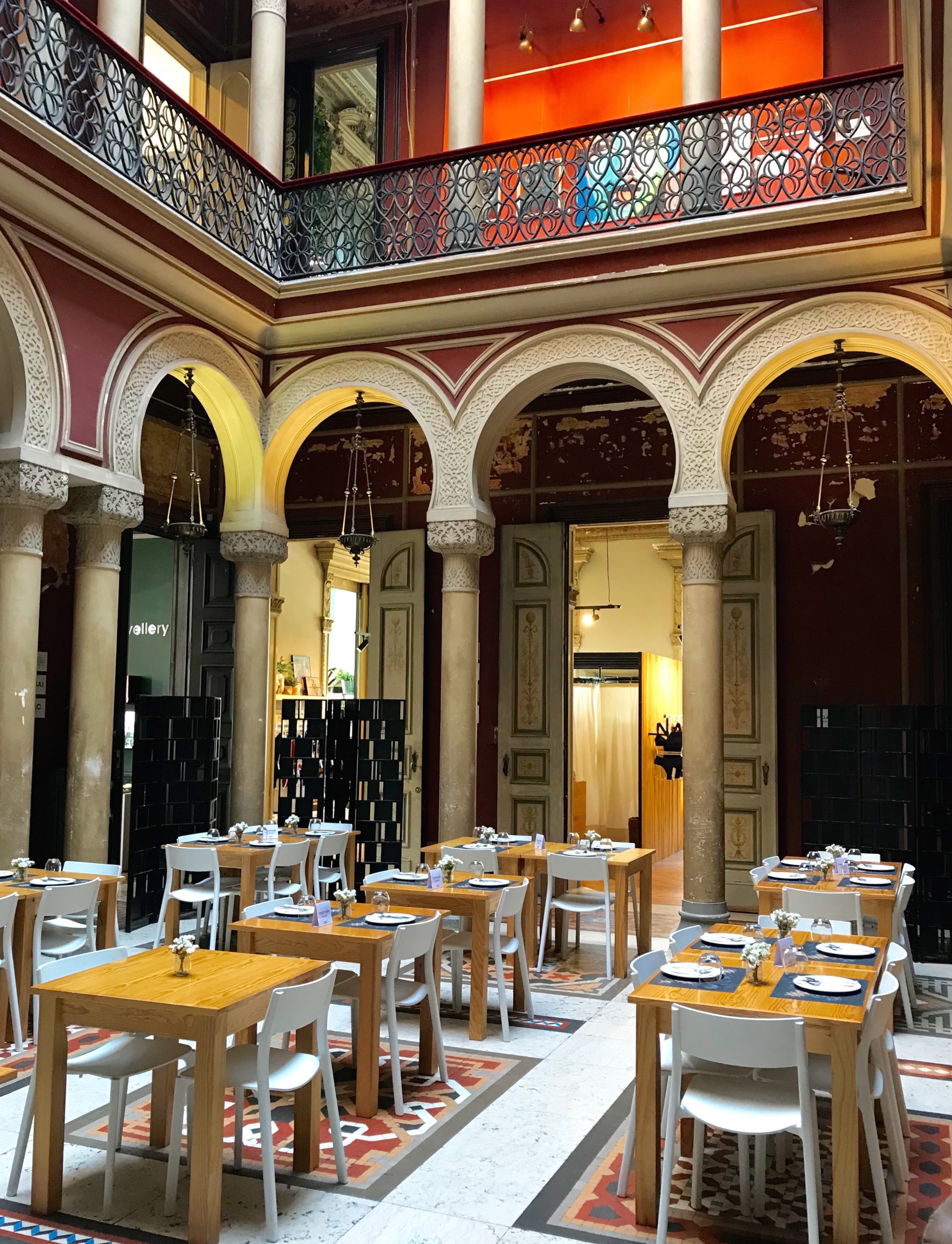
Restaurant Less at the Ribeiro da Cunha Palace.
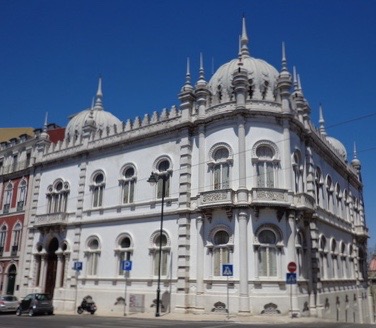
Moorish architectural gem — Ribeiro da Cunha Palace also known as the Embaixada.
Carolina mentions that she’s a bit homesick. We ask her to play a couple of Sambas to honor Rio on the restaurant sound system. Her smile lights up the entire vaulted room. Minutes later, sweet notes from João & Astrid Gilberto float through the air. Carolina sashays back over to our table and we sing a few Portuguese/English duets.
Finally, back in our room at Casa do Príncipe, we open the balcony doors and listen to the night birds in the botanical gardens. Soft breezes carry an intoxicating mix of fragrances: roses, magnolias, jasmine and lavender. The cherubs on the ceiling seem to wink from their cloudy perch. It’s a perfect ending to our lightning fast tour of Lisbon and Portugal.
FOR THE NEXT TRIP
On our flight back, we reminisce about our time in Portugal and also discuss what we’d do differently on a return visit. Here’s our list:
1) Use a car as little as possible. Between the impossibly narrow roads, non-existent parking, fees, fines and “opportunistic” law-enforcement, cars are a huge headache. We would definitely make use of city tour buses, especially in Lisbon. We’d also thoroughly research parking facilities provided by hotels. As we learned, hotels claiming to have “Parking Available” don’t always provide parking on premise.
2) ABSOLUTELY avoid visiting in high season. We consider ourselves pretty savvy travelers, but we were caught off guard by the huge crowds in Portugal, particularly Lisbon. In 2017, the number of foreign tourists to Portugal rose nearly 12% up to a record-breaking 12.7 million people. (Afar Magazine). This Summer 2018, there will be 91 weekly flights from the United States to Porto and Lisbon, twice as many as there were in 2017. (Conde Nast Traveler) Bottom line – avoid traveling in late-Spring and Summer months if at all possible.
3) Don’t expect bargain basement prices. Portugal is still very affordable. However, super bargains are a thing of the past. Again, traveling off-season and researching rates and prices will help defray costs.
Finally, a special note for our Wine Lovers: If you’re interested in Port wines be sure to check out the film A Year in Port and see our interview with the filmmakers.




